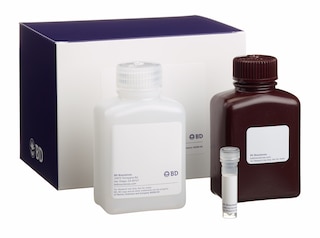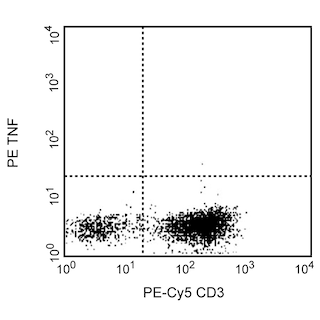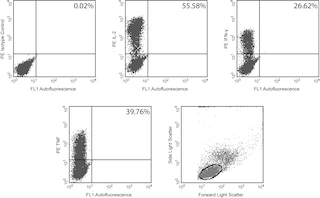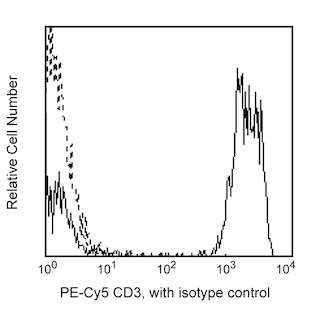Old Browser
Looks like you're visiting us from {countryName}.
Would you like to stay on the current country site or be switched to your country?




Expression of TNF by stimulated human peripheral blood mononuclear cells (PBMC). Human PBMC were stimulated for 6 hours with PMA (Sigma, Cat. #P-8139) and calcium ionophore A23187 (Sigma, Cat. #C-9275) in the presence of GolgiStop™ (2 µM final concentration; Cat. No. 554715). The PBMC were stained with PE-Cy™5 Mouse Anti-Human CD3 (Cat. No. 555334), fixed, permeabilized, and subsequently stained with 0.25 µg of FITC Mouse Anti-Human TNF (Cat. No. 554512, left panel). To demonstrate specificity of staining, the binding of FITC Mouse Anti-Human TNF was blocked by the preincubation of the fluorochrome-conjugated antibody with recombinant human TNF (5 µg, Cat. No. 554618; middle panel), and by preincubation of the fixed/permeabilized cells with Purified Mouse Anti-Human TNF (5 µg, Cat. No. 554510/558882; right panel) prior to staining with the FITC Mouse Anti-Human TNF. The quadrant markers for the bivariate dot plots were set based on the autofluorescence control, and verified with the recombinant cytokine blocking and unlabeled antibody blocking specificity controls.


BD Pharmingen™ Purified Mouse Anti-Human TNF

Regulatory Status Legend
Any use of products other than the permitted use without the express written authorization of Becton, Dickinson and Company is strictly prohibited.
Preparation And Storage
Recommended Assay Procedures
Blocking Control for Intracellular Staining: Purified Mouse Anti-Human TNF can be used as a blocking control to demonstrate specificity of TNF staining by PE Mouse Anti-Human TNF (Cat. No. 554513) or FITC Mouse Anti-Human TNF antibody (Cat. No. 554512). To perform this control, the fixed/permeabilized cells (~1 million) can be incubated with 1 -10 µg of Purified Mouse Anti-Human TNF (Cat. No. 554510) for 20 minutes at 4°C, prior to staining with PE Mouse Anti-Human TNF or FITC Mouse Anti-Human TNF antibody (e.g., 0.1 - 0.5 µg mAb/1 million cells). The intracellular cytokine staining technique and use of blocking controls are described in detail by C. Prussin and D. Metcalfe. For specific methodology, please visit the protocols section under "Cytokines (Intracellular Staining)" or "Intracellular Flow" at our website, http://www.bdbiosciences.com/us/s/resources.
Product Notices
- Since applications vary, each investigator should titrate the reagent to obtain optimal results.
- An isotype control should be used at the same concentration as the antibody of interest.
- Caution: Sodium azide yields highly toxic hydrazoic acid under acidic conditions. Dilute azide compounds in running water before discarding to avoid accumulation of potentially explosive deposits in plumbing.
- Sodium azide is a reversible inhibitor of oxidative metabolism; therefore, antibody preparations containing this preservative agent must not be used in cell cultures nor injected into animals. Sodium azide may be removed by washing stained cells or plate-bound antibody or dialyzing soluble antibody in sodium azide-free buffer. Since endotoxin may also affect the results of functional studies, we recommend the NA/LE (No Azide/Low Endotoxin) antibody format, if available, for in vitro and in vivo use.
- Species cross-reactivity detected in product development may not have been confirmed on every format and/or application.
- Please refer to http://regdocs.bd.com to access safety data sheets (SDS).
- Please refer to www.bdbiosciences.com/us/s/resources for technical protocols.
Companion Products






The MAb11 monoclonal antibody specifically binds to human tumor necrosis factor (TNF, also known as TNF-α) protein. TNF is an efficient juxtacrine, paracrine and endocrine mediator of inflammatory and immune functions. It regulates the growth and differentiation of a variety of cell types. TNF is cytotoxic for transformed cells when in conjunction with IFN-γ. It is secreted by activated monocytes/macrophages and other cells such as B cells, T cells and fibroblasts. The immunogen used to generate the MAb11 hybridoma was recombinant human TNF. The MAb11 antibody has been reported to crossreact with Rhesus Macaque TNF.
Development References (7)
-
Danis VA, Franic GM, Rathjen DA, Brooks PM. Effects of granulocyte-macrophage colony-stimulating factor (GM-CSF), IL-2, interferon-gamma (IFN-gamma), tumour necrosis factor-alpha (TNF-alpha) and IL-6 on the production of immunoreactive IL-1 and TNF-alpha by human monocytes. Clin Exp Immunol. 1991; 85(1):143-150. (Clone-specific: ELISA). View Reference
-
Jason J, Larned J. Single-cell cytokine profiles in normal humans: comparison of flow cytometric reagents and stimulation protocols. J Immunol Methods. 1997; 207(1):13-22. (Biology). View Reference
-
Prussin C, Metcalfe DD. Detection of intracytoplasmic cytokine using flow cytometry and directly conjugated anti-cytokine antibodies. J Immunol Methods. 1995; 188(1):117-128. (Methodology: IC/FCM Block). View Reference
-
Rathjen DA, Cowan K, Furphy LJ, Aston R. Antigenic structure of human tumour necrosis factor: recognition of distinct regions of TNF alpha by different tumour cell receptors. Mol Immunol. 1991; 28(1-2):79-86. (Clone-specific: ELISA). View Reference
-
Sander B, Andersson J, Andersson U. Assessment of cytokines by immunofluorescence and the paraformaldehyde-saponin procedure. Immunol Rev. 1991; 119:65-93. (Biology). View Reference
-
Sopper S, Stahl-Hennig C, Demuth M, Johnston IC, Dorries R, ter Meulen V. Lymphocyte subsets and expression of differentiation markers in blood and lymphoid organs of rhesus monkeys. Cytometry. 1997; 29(4):351-362. (Biology). View Reference
-
Verdier F, Aujoulat M, Condevaux F, Descotes J. Determination of lymphocyte subsets and cytokine levels in cynomolgus monkeys. Toxicology. 1995; 105(1):81-90. (Biology). View Reference
Please refer to Support Documents for Quality Certificates
Global - Refer to manufacturer's instructions for use and related User Manuals and Technical data sheets before using this products as described
Comparisons, where applicable, are made against older BD Technology, manual methods or are general performance claims. Comparisons are not made against non-BD technologies, unless otherwise noted.
For Research Use Only. Not for use in diagnostic or therapeutic procedures.
Report a Site Issue
This form is intended to help us improve our website experience. For other support, please visit our Contact Us page.